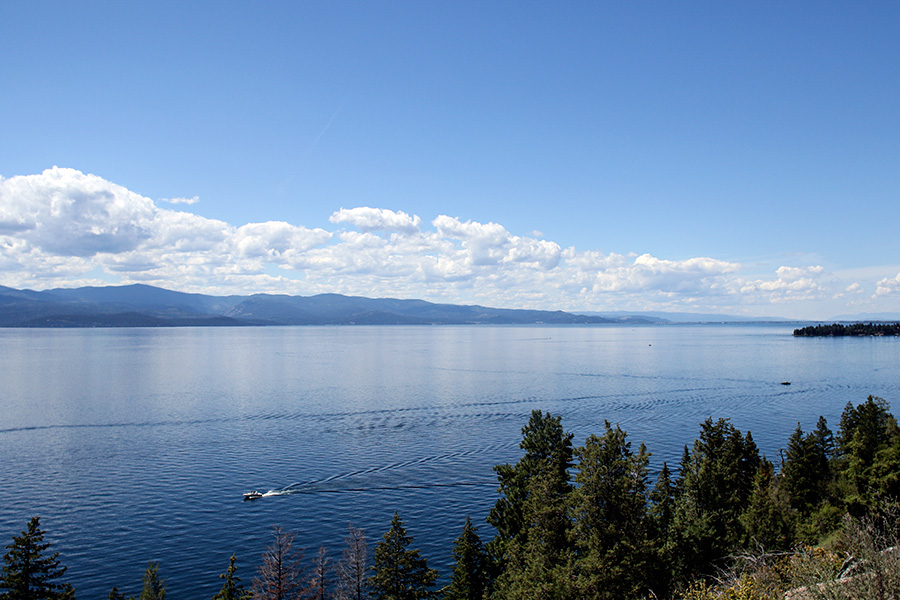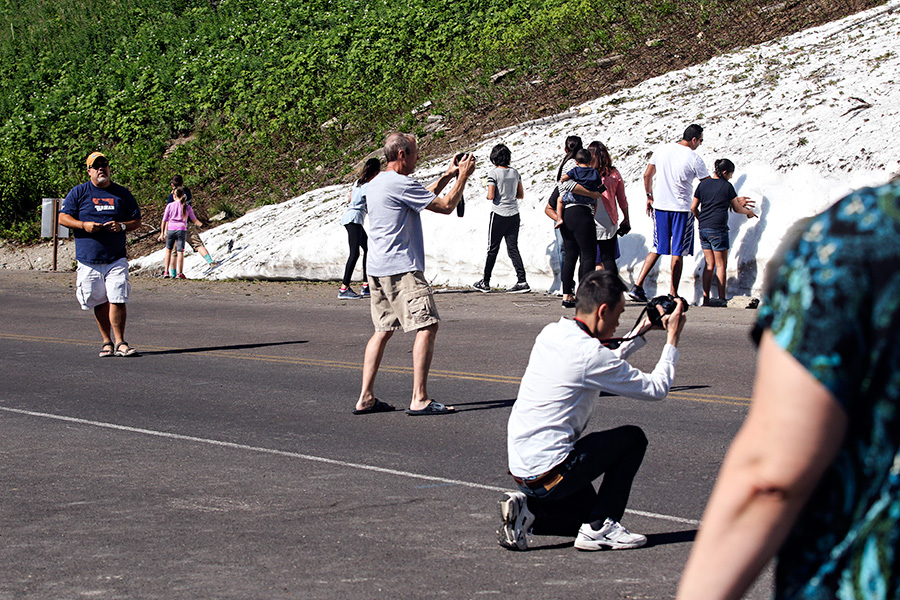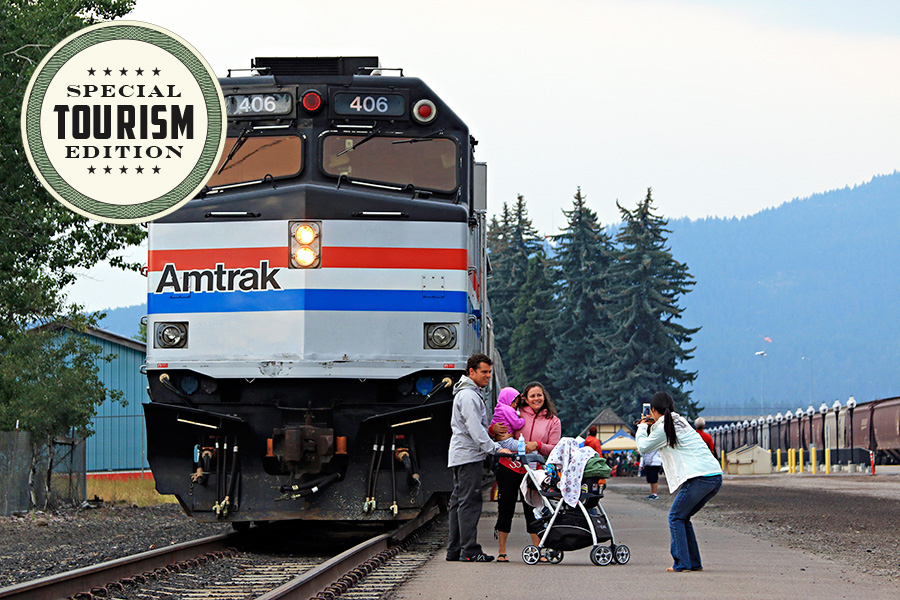LAKE MCDONALD — Standing on the shore of the largest lake in Glacier National Park, the motorcyclists were clad in merely their swimsuits and motorcycle boots, an attempt to beat the heat as they made their way through the scenery.
The four friends had ridden their motorcycles from Seattle, up through Canada to tour Banff and Jasper national parks before dropping down to Northwest Montana. They had to see Glacier, and knew they had an advantage on their bikes.
“The best part so far? Having a motorcycle and being able to park at Logan Pass,” Matt Olson said as he gathered up his clothes from the beach.
With plans to make it to the Idaho panhandle that night, they had to get a move on. But not before asking another park visitor to snap photos of them riding their motorcycles in their bathing suits on Going-to-the-Sun Road, so they could show their moms.
_____________________
MORE FROM THIS SERIES
Montana as Tourist Magnet
Despite Influx of Vacation Rentals, Traditional Lodging Remains Strong
Finding Help in the Flathead
Glacier at the Halfway Point: Sun, Crowds, Traffic
_____________________
On the way out of the valley, the foursome planned to stop in Whitefish for the Tuesday night farmers market; a dearth of vegetables on the eastside of the park had them craving fresh produce.
“Otherwise it’s been great,” Morgan Newberg said before preparing to ride west again.
By the Numbers
Attracted by the scenery, visitors come to the Treasure State in droves, especially during the summer, to explore the best of what Montana has to offer, and communities in the Flathead Valley and throughout the state have made efforts to actively retain the people flowing down the streets and highways.
Tourism has always been a piece of Montana’s economic fabric, with the mountains, lakes, plains, and forests calling out to the human spirit of adventure. But it has taken on greater importance in places such as Northwest Montana, where the recession dealt severe blows to the former mainstay industries that depended on natural-resource extraction.
According to the Institute for Tourism and Recreation Research at the University of Montana, tourists pumped $3.5 billion into the state economy in 2016, directly supporting more than 38,000 jobs and generating about $194 million in state and local taxes.
The National Park Service records Glacier’s 2016 impact on the local economy as $250.8 million, with hotels reaping the lion’s share. For comparison, the park’s economic impact in 2012 was $172.4 million.
Americans are headed back outside in record numbers, according to the National Park Service, with more than 331 million people visiting America’s 417 NPS sites in 2016.
With that in mind, the Montana Office of Tourism, a division of the state Department of Commerce, conducted a survey of tourism stakeholders as well as 6,245 tourists from 17 key domestic and Canadian markets.
The resulting information paints a picture of a state on the brink of fully realizing its tourism potential, with marketing and branding challenges and opportunities in major visitor markets.
Pam Haxby-Cote, director of the state Department of Commerce, said the state’s branding project came to life about a decade ago with the realization that a unified approach to tourism could improve it for hundreds of stakeholders.
“Since then, we’ve remained at the forefront of destination marketing through innovation, research and awareness of the latest trends,” Haxby-Cote said.

Wild Adventure
One of Montana’s most obvious strengths for drawing tourists is its unique beauty, the report noted. The state remains largely unspoiled in the minds of many potential visitors, including the Fauberts, who came up from California to spend time with family.
Last week, they’d found a slice of heaven on the beach at Wayfarers’ State Park near Bigfork, sitting under the shade of a pop-up tent as the heat of the day made the lake’s cool water even more inviting.
As Huntington Beach residents, the Fauberts flew to Montana and said the air travel was simple to arrange. They were blown away by the scenery, and had a particularly fun time on the zipline course at Whitefish Mountain Resort.
“It was really fun,” Bella Faubert said. “The scenery was beautiful; it’s better than California.”
The family also saw a black bear and a deer, she said.
While Glacier and Yellowstone national parks have direct appeal across the country, the report noted that Montana’s state park system is a “true gem” that can really bring a whole trip together. Wildlife is also an attraction, the report said, with people excited for the chance to see animals so far outside their everyday lives.
On the other side of the lake at West Shore State Park, people peppered the beaches seeking water and sun. A family from Oregon played onshore; Arianna, who believes a vital part of vacation is anonymity, said they pulled over on their way to Glacier Park to explore the lake.
“We saw pictures of Flathead Lake and wanted to stop to check it out,” she said.

Crowding in an Uncrowded Place
Montana’s open spaces and relatively low population make it a destination for tourists, the report said. But for some visitors, the crush of crowds is just part of the trip.
John and Sheila Mathews drove their truck, Big Red, from Molene, Illinois to Columbia Falls, where they left their fifth-wheel trailer at an RV park and took the truck to West Glacier.
“Glacier is the reason we came this far,” John Mathews said.
The couple had planned the trip for six months, and they were impressed with Montana. However, driving Going-to-the-Sun Road presented a challenge with their large vehicle; there was also a brief scare of a child popping up out of roadside shrubs and onto the pavement.
“There were so many people driving over the yellow line,” Sheila Mathews said, “and people let their kids out on that road up there.”
With Glacier Park more popular than ever — a record 621,000 people visited this June, while 2.9 million people visited in 2016, another record — park officials are focused on alleviating traffic jams through various means, including a free shuttle service on the Sun Road. But Glacier Park Superintendent Jeff Mow said that crowds toward the end of summer might have to be part of a Glacier visitor’s expectations.
The state’s tourism office said the conversation about national park capacity naturally provides opportunity for other parts of the state.
“For at least the past three to four years, we’ve directed efforts toward promoting shoulder seasons, locations in between the parks, and niche activities,” Haxby-Cote said. “Two years ago, we even replaced our traditional guidebook with a National Geographic co-branded guide to Montana’s ultimate road trips.”
“By spreading the word about Montana’s many other attractions and activities,” she continued, “visitors to the national parks are more likely to extend their stay or return to Montana another time to explore other areas.”
Tricky Logistics
Infrastructure challenges, including air access, are among the larger issues facing Montana and its brand perception, according to the report. In the Flathead, the AERO group has worked to bring more flights to Glacier Park International Airport, but plane tickets can still be expensive when compared to other tourist destinations.
Cathy Wade was enjoying the Flathead Lake shoreline last week while on a trip to visit her son, Greyson Wade, who is spending the summer performing at the Bigfork Summer Playhouse.
The Wades knew they wanted to visit Montana, but were put off by the plane ticket prices. So instead of flying into GPIA, they flew to Calgary and drove the nearly 270 miles to Bigfork, stopping at Canada’s scenic parks along the way.
The $6 state park entrance fee was well worth it, though, she added. Haxby-Cote said it’s easier than ever for visitors to get to Montana, and that message has been built into the marketing.
“Access by air is continually improving,” she said. “Communities across the state have been leading the charge on securing new flights to their areas, and we’ve worked with these communities to provide marketing support to ensure the flights are successful.”
